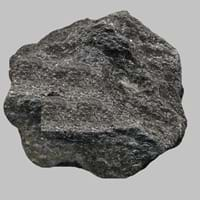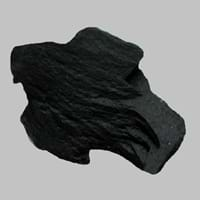Definition
A ganister is a hard, fine-grained quartzose sandstone or orthoquartzite which is basically used in the manufacture of silica brick typically used to line furnaces and is a type of sedimentary rocks.
Lignite is a soft brownish coal which shows traces of plants and is intermediate between bituminous coal and peat
Discoverer
Unknown
Unknown
Etymology
From gan′is-ter i.e a hard, close-grained siliceous stone, often forming the stratum which underlies a coal-seam
From French, Latin lignum wood + -ite1
Class
Sedimentary Rocks
Sedimentary Rocks
Sub-Class
Durable Rock, Hard Rock
Durable Rock, Soft Rock
Group
Not Applicable
Not Applicable
Other Categories
Coarse Grained Rock, Fine Grained Rock, Opaque Rock
Coarse Grained Rock, Fine Grained Rock, Medium Grained Rock, Opaque Rock
Texture
Clastic, Granular, Rough
Amorphous, Glassy
Color
Beige, Black, Brown, Colourless, Cream, Dark Brown, Green, Grey, Light Green, Light to Dark Grey, Pink, Red, White, Yellow
Black, Brown, Dark Brown, Grey, Light to Dark Grey
Durability
Durable
Durable
Appearance
Rough
Veined or Pebbled
Interior Uses
Decorative Aggregates, Entryways, Flooring, Homes, Interior Decoration
Not Yet Used
Exterior Uses
As Building Stone, Garden Decoration, Office Buildings, Paving Stone
Not Yet Used
Other Architectural Uses
Curbing
Not Yet Used
Construction Industry
Cement Manufacture, Construction Aggregate, for Road Aggregate, Production of Glass and Ceramics, Raw material for the manufacture of mortar
for Road Aggregate, Steel Production
Medical Industry
Not Yet Used
Not Yet Used
Antiquity Uses
Artifacts, Monuments, Sculpture, Small Figurines
Not Yet Used
Commercial Uses
An Oil and Gas Reservoir, In aquifers, Petroleum reservoirs, Soil Conditioner, Source of Magnesia (MgO), Tombstones
Electricity Generation
Types
Not Available
Xyloid Lignite or Fossil Wood and Compact Lignite or Perfect Lignite
Features
Available in Lots of Colors and Patterns, Generally rough to touch, Very fine grained rock
Generally rough to touch, Helps in production of Heat and Electricity, Used as fossil fuel
Archaeological Significance
Monuments
Used
Not Yet Used
Famous Monuments
Data Not Available
Not Applicable
Sculpture
Used
Not Yet Used
Famous Sculptures
Data Not Available
Not Applicable
Pictographs
Not Used
Used
Petroglyphs
Not Used
Used
Figurines
Used
Not Yet Used
Formation
Ganisters are formed by the destruction of easily weathered minerals mainly feldspar, within the surface horizon of soil by soil-forming processes.
Coal formation takes place due to accumulation of plant debris in a swamp environment. The Coal formation process continues, as peat turns into lignite brown or black coal at increasing heat and pressure.
Mineral Content
Calcite, Clay, Clay Minerals, Feldspar, Micas, Quartz
Not Available
Compound Content
Aluminium Oxide, CaO, Iron(III) Oxide, Potassium Oxide, MgO, Sodium Oxide, Silicon Dioxide
Carbon, Hydrogen, Nitrogen, Oxygen, Sulphur
Types of Metamorphism
Not Applicable
Not Applicable
Types of Weathering
Biological Weathering
Biological Weathering, Chemical Weathering, Mechanical Weathering
Types of Erosion
Water Erosion, Wind Erosion
Chemical Erosion, Water Erosion, Wind Erosion
Grain Size
Coarse or Fine
Medium to Fine Coarse Grained
Fracture
Splintery
Conchoidal
Porosity
Highly Porous
Highly Porous
Luster
Dull
Dull to Vitreous to Submetallic
Compressive Strength
Not Available
Cleavage
Perfect
Non-Existent
Toughness
2.6
Not Available
Specific Gravity
2.2-2.8
1.1-1.4
Transparency
Opaque
Opaque
Density
2.2-2.8 g/cm3
800-801 g/cm3
Resistance
Heat Resistant, Impact Resistant, Pressure Resistant
Heat Resistant
Deposits in Eastern Continents
Asia
China, India, Kazakhstan, Mongolia, Russia, Uzbekistan
Bangladesh, Burma, Cambodia, China, India, Indonesia, Kazakhstan, Malaysia, Mongolia, Pakistan, Turkey, Vietnam
Africa
Namibia, Nigeria, South Africa
Botswana, Kenya, Morocco, Mozambique, South Africa, Tanzania
Europe
Austria, Denmark, Germany, Great Britain, Netherlands, Norway, Poland, Sweden, Switzerland, United Kingdom
Belgium, Bulgaria, England, France, Germany, Greece, Hungary, Kosovo, Netherlands, Norway, Poland, Romania, Serbia, Slovakia, Slovenia, The Czech Republic, Ukraine, United Kingdom
Others
Greenland
Not Yet Found
Deposits in Western Continents
North America
Canada, USA
Canada, Mexico, USA
South America
Brazil
Brazil, Chile, Colombia, Venezuela
Deposits in Oceania Continent
Australia
New South Wales, New Zealand
New South Wales, Queensland, Victoria
Ganister vs Lignite Characteristics
Though some rocks look identical, they have certain characteristics which distinguish them from others. Characteristics of rocks include texture, appearance, color, fracture, streak, hardness etc. Ganister vs Lignite characteristics assist us to distinguish and recognize rocks. Also you can check about Properties of Ganister and Properties of Lignite. Learn more about Ganister vs Lignite in the next section. The interior uses of Ganister include Decorative aggregates, Entryways, Flooring, Homes and Interior decoration whereas the interior uses of Lignite include Not yet used. Due to some exceptional properties of Ganister and Lignite, they have various applications in construction industry. The uses of Ganister in construction industry include Cement manufacture, Construction aggregate, For road aggregate, Production of glass and ceramics, Raw material for the manufacture of mortar and that of Lignite include For road aggregate, Steel production.
More about Ganister and Lignite
Here you can know more about Ganister and Lignite. The life cycle of a rock consists of formation of rock, composition of rock and transformation of rock. The composition of Ganister and Lignite consists of mineral content and compound content. The mineral content of Ganister includes Calcite, Clay, Clay Minerals, Feldspar, Micas, Quartz and mineral content of Lignite is not available. You can also check out the list of all Sedimentary Rocks. When we have to compare Ganister vs Lignite, the texture, color and appearance plays an important role in determining the type of rock. Ganister is available in beige, black, brown, colourless, cream, dark brown, green, grey, light green, light to dark grey, pink, red, white, yellow colors whereas, Lignite is available in black, brown, dark brown, grey, light to dark grey colors. Appearance of Ganister is Rough and that of Lignite is Veined or Pebbled. Properties of rock is another aspect for Ganister vs Lignite. The hardness of Ganister is 6-7 and that of Lignite is 1. The types of Ganister are Not Available whereas types of Lignite are Xyloid Lignite or Fossil Wood and Compact Lignite or Perfect Lignite. Streak of rock is the color of powder produced when it is dragged across an unweathered surface. The streak of Ganister is white while that of Lignite is black. The specific heat capacity of Ganister is 0.92 kJ/Kg K and that of Lignite is 1.26 kJ/Kg K. Depending on the properties like hardness, toughness, specific heat capacity, porosity etc., rocks are resistant to heat, wear, impact, etc.Ganister is heat resistant, impact resistant, pressure resistant whereas Lignite is heat resistant.





